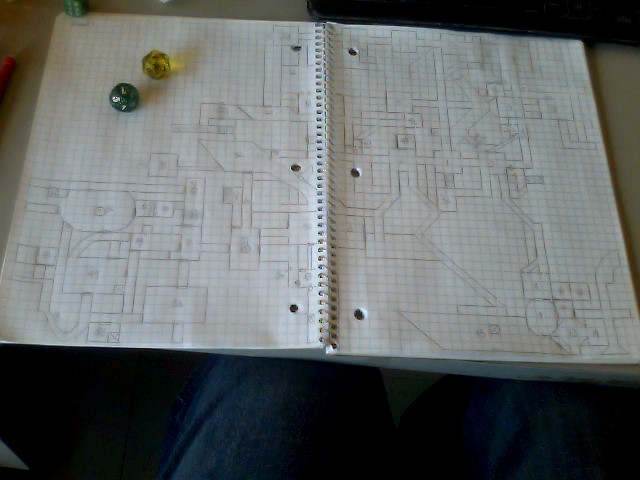Random Dungeon Generation

-

-
| - | - | - | - | - | Start Areas | - | - | - | - | - |
| I.: Periodic Check | - | - | - | - | - | - | - | - | - | - |
| II.: Doors | - | - | - | - | - | - | - | - | - | - |
| III.: Side Passages | III.A.: Passage Width | Table III. B.: Special Passage | - | - | - | - | - | - | - | - |
| IV.: Turns | - | - | - | - | - | - | - | - | - | - |
| V.: Chambers and Rooms Shape and Size | V.A.:
Unusual Shape |
V.B.:
Unusual Size |
V.C.: Number of Exits | V.D.: Exit Location | V.E.: Exit Direction | V.F.: Chamber or Room Contents | V.G.: Treasure | V.H.: Treasure is Contained In | V.I.: Treasure is Guarded By | V.J.: Treasure is Hidden By/In |
| VI.: Stairs | - | - | - | - | - | - | - | - | - | - |
| VII.: Trick/Trap | VII.A.: Gas Sub-Table | - | - | - | - | - | - | - | - | - |
| VIII.: Caves and Caverns | VIII.A.: Pools | VIII. B.: Lakes | VIII.C.: Magic Pools | - | - | - | - | - | - | - |
| - | - | - | - | - | Random Dungeon Generation for Solo Play | - | - | - | - | - |
| Appendices | - | - | - | - | - | - | - | - | - | DMG |
When you need help in designing a dungeon
- whether it is a level in
your main dungeon || a labyrinth discovered
elsewhere - the following
random generation system has proven itself
to be useful. It must be noted
that the system requires time, but it
can be used directly in conjunction
with actual play.
The upper level above the dungeon
in which adventures are to take place
should be completely planned out, and
it is a good idea to use the outdoor
encounter matrix to see what lives where
(a staircase discovered later just
might lead right into the midst of whatever
it is). The stairway down to the
first level of the dungeon should be situated
in the approximate middle of
the upper ruins (or whatever you have
as upper works).
The first level of the dungeon is
always begun with a room; that is, the
stairway down leads to a room, so you
might go immediately to TABLE V.
and follow the procedure indicated or
use one of the following ”starter”
areas. Always begin a level in the middle
of the sheet of graph paper.
Keep a side record of all monsters, treasures,
trick/traps, and whatever -- a
normal dungeon matrix.
Discretion must prevail at all times.
For example: if you have decided that
a level is to be but one sheet of paper
in size, and the die result calls for
something which goes beyond an edge, amend
the result by rolling until
you obtain something which will fit with
your predetermined limits.
Common sense will serve. If a room won’t
fit, a smaller one must serve,
and any room or chamber which is called
for can be otherwise drawn to
suit what you believe to be its best positioning.
START AREAS FOR RANDOM DUNGEON
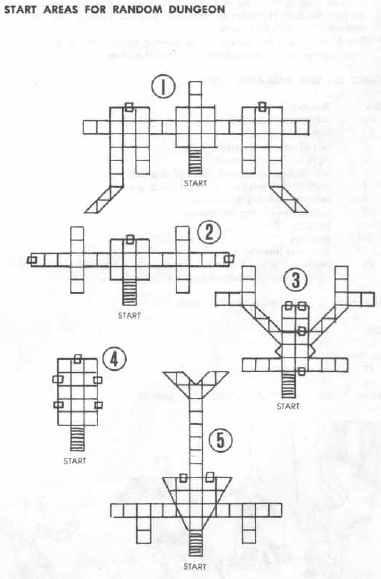
TABLE I.: PERIODIC CHECK (d20)
| Die | Result |
| 1-2 | Continue straight -- check again in 60' (this table) |
| 3-5 | Door (see TABLE II.) |
| 6-10 | Side |
| 11-13 | Passage Turns (see TABLE IV., check width on TABLE IIIa.) -- check again in 30' (this table) <corrected to: 3a> |
| 14-16 | Chamber (see TABLE V.) -- check 30' after leaving (this table) |
| 17 | Stairs (see TABLE VI.) |
| 18 | Dead End (walls left, right, and ahead can be checked for Secret Doors, see TABLE V.D., footnote) |
| 19 | Trick/trap (see TABLE VII.), passage continues- check again in 30' (this table) |
| 20 | Wandering Monster, check again immediately to see what lies ahead so direction of monster's approach can be determined. |
TABLE II.: DOORS* (d20)

Location of Door Space Beyond Door Is:
| Die | Result | Die | Result |
| 1-6 | Left | 1-4 | Parallel passage**, or 10 ' x 10' room if passage straight ahead |
| 7-12 | Right | 5-8 | Passage straight ahead |
| 13-20 | Ahead | 9 | Passage 45 degrees ahead/behind*** |
| - | - | 10 | Passage 45 degrees behind/ahead*** |
| - | - | 11-18 | Room (go to TABLE V.) |
| - | - | 19-20 | Chamber (go to TABLE V.) |
Always check width of passage
* Check again immediately on TABLE
I. unless door is straight ahead; if another door is not indicated,
then ignore the result and check again
30' past the door. If a room or chamber
is beyond a door, go to TABLE V.
**Extends 30' in both directions.
***The direction will be appropriate to
existing circumstances, but use the
direction before the slash in preference
to the other.
TABLE III.: SIDE PASSAGES (d20)

| Die | Result |
| 1-2 | left 90 degrees |
| 3-4 | right 90 degrees |
| 5 | left 45 degrees ahead |
| 6 | right 45 degrees ahead |
| 7 | left 45 degrees behind (left 135 degrees) |
| 8 | right 45 degrees behind (right 135 degrees) |
| 9 | left curve 45 degrees ahead |
| 10 | right curve 45 degrees ahead |
| 11-13 | passage "T"s |
| 14-15 | passage "Y's |
| 16-19 | four-way intersection |
| 20 | passage "X"s
(if present passage is horizontal or vertical it forms a fifth passage into the "X") |
-
TABLE III.
A.: PASSAGE WIDTH (d20)
| Die | Result |
| 1-12 | 10' |
| 13-16 | 20' |
| 17 | 30' |
| 18 | 5' |
| 19-20 | SPECIAL PASSAGE (TABLE III. B. below) |
TABLE III. B.: SPECIAL PASSAGE (d20)

| Die | Result |
| 1-4 | 40', columns down center |
| 5-7 | 40', double row of columns |
| 8-10 | 50', double row of columns |
| 11-12 | 50', columns 10' right and left support 10' wide upper galleries 20' above* |
| 13-15 | 10 ' stream** |
| 16-17 | 20' river*** |
| 18 | 40' river*** |
| 19 | 60' river*** |
| 20 | 20', chasm**** |
* Stairs up to gallery will be at end of
passage (1-15) or at beginning (16-20).
In the former case if a stairway is indicated
in or adjacent to the passage it will replace the end stairs 50% (1-10)
of the time and supplement 50% (11-20) of the time.
** Streams
bisect the passage. They will be bridged 75% (1-15) of the
time and be an obstacle 25% (16-20) of
the time.
*** Rivers
bisect the passage. They will be bridged 50% (1-10) of the
time, have a boat 25% (11-15) of the time
(50% chance for either
bank), and be an obstacle 25% of the time.
**** Chasms
bisect the passage. They are 150' to 200' deep. They will be
bridged
50% (1-10) of the time, have a jumping place 5'-10' wide
25% (1 1-15) of the time, and be an obstacle
25% (16-20) of the time.

| Die | Result |
| 1-8 | left 90º |
| 9 | left 45º ahead |
| 10 | left 45º behind (left 135 degrees) |
| 11-18 | right 90º |
| 19 | right 45º ahead |
| 20 | right 45º behind |
TABLE V.: CHAMBERS
&& ROOMS SHAPE AND SIZE (d20)
(Roll for Shape,
Size, and Exits; then Contents, Treasure,
and how the latter is contained, if applicable.)
| Die | Chamber Shape and Area <(Optional: Exits are Doors)> | Room Shape and Area <(Optional: Exits are Passageways. Passage Width.)> |
| 1-2 | Square, 20'x20' | Square,10'x10' |
| 3-4 | Square, 20' x 20' | Square, 20' x 20' |
| 5-6 | Square, 30' x 30' | Square, 30' x 30' |
| 7-8 | Square, 40' x 40' | Square, 40' x 40' |
| 9-10 | Rectangular, 20' x 30' | Rectangular, 10' x 20' |
| 11-13 | Rectangular, 20' x 30' | Rectangular, 20' x 30' |
| 14-15 | Rectangular, 30' x 50' | Rectangular, 20' x 40' |
| 16-17 | Rectangular, 40' x 60' | Rectangular, 30' x 40' |
| 18-20 | Unusual shape and size - see sub-tables below | Unusual shape and size - see sub-tables below |
TABLE V. A.: UNUSUAL SHAPE (d20)
| Die | Shape |
| 1-5 | Circular* |
| 6-8 | Triangular |
| 9-11 | Trapezoidal |
| 12-13 | Odd-Shaped** |
| 14-15 | Oval |
| 16-17 | Hexagonal |
| 18-19 | Octagonal |
| 20 | Cave |
* 1-5 has pool (see TABLE
VIII. A. and C. if appropriate), 6-7 has well, 8-10
has shaft, and 11-20 is normal.
** Draw what shape you desire or what
will fit the map - it is a special.
TABLEV. B.: UNUSUAL SIZE (d20)
| Die | Size |
| 1-3 | about 500 sq. ft. |
| 4-6 | about 900 sq. ft. |
| 7-8 | about 1300 sq. ft. |
| 9-10 | about 2000 sq. ft. |
| 11-12 | about 2700 sq. ft. |
| 13-14 | about 3400 sq. ft. |
| 15-20 | roll again and add result to 9-10 above (if another 15-20 repeat the process, doubling 9-10 above, and so on) |
TABLE V.C.: NUMBER OF EXITS (d20) <(Optional: 50% chance of exit on each wall. Randomly generate square of exit. eg. d3 if the wall is 30'.)>
| Die | Room Area | Number of Exits |
| 1-3 | up to 600' | 1 |
| 1-3 | over 600' | 2 |
| 4-6 | up to 600' | 2 |
| 4-6 | over 600' | 3 |
| 7-9 | up to 600' | 3 |
| 7-9 | over 600' | 4 |
| 10-12 | up to 1200' | 0* |
| 10-12 | over 1200' | 1 |
| 13-15 | up to 1600' | 0* |
| 13-15 | over 1600' | 1 |
| 16-18 | any size | 1-4 |
| 19-20 | any size | 1 -- door in chamber, passage in room |
* Check once per 10' for secret doors (see TABLE V. D., footnote).
TABLEV.D.: EXIT LOCATION (d20)
| Die* | Location |
| 1-7 | opposite wall |
| 8-12 | left wall |
| 13-17 | right wall |
| 18-20 | same wall |
* If a passage || door
is indicated in a wall where the space immediately beyond the wall has
already been mapped,
then the exit is either a secret
door (1-5) or a one-way door (6-10) or it is in the opposite direction
(11-20).
TABLE V.E.: EXIT DIRECTION (d20)
| Die | Direction (if a Door use TABLE
II instead) -- check for width on TABLE III A.
<"1 -- door in chamber, passage in room"> |
| 1-16 | straight ahead |
| 17-18 | 45 degrees left/right* |
| 19-20 | 45 degrees right/left* |
* The exit will be appropriate to existing circumstances, but use the direction before the slash in preference to the other.
TABLE V. F.: ROOM CONTENTS (d20) <(5f)> <(Optional: Roll TWICE on this table.)>
| Die | Contents |
| 1-12 | empty |
| 13-14 | Monster only (determine on appropriate table from APPENDIX C: RANDOM MONSTER ENCOUNTERS, Dungeon Encounter Matrix). |
| 15-17 | Monster && treasure (see TABLE V.G. below) |
| 18 | Special*,
or contains stairway up 1 level (1-5), up 2 levels (7-8), down 1 level (9-14), down 2 levels (15-19), or down 3 levels -- 2 flights of stairs and a slanting passageway (20).
|
| 19 | Trick/trap (see TABLE VII.) |
| 20 | Treasure (see TABLE V.G..) |
* Determine by balance of level or put in what you desire; otherwise put in stairs as indicated.
| Die | Without Monster | With Monster |
| 01-25 | 1,000 copper pieces/level | Take two rolls on "Without Monster" Table,
add 10% to the total of each roll. |
| 26-50 | 1,000 silver pieces/level | - |
| 51-65 | 750 electrum pieces/level | - |
| 66-80 | 250 gold pieces/level | - |
| 81-90 | 100 platinum pieces/level | - |
| 91-94 | 1-4 gems/level | - |
| 95-97 | 1 piece jewelry/level | - |
| 98-00 | Magic (roll once on Magic Items Table) <> | - |
* See also TABLES V. H.
and I. or
J.
<(Optional: 50% chance to check I or
J).>
TABLE V. H.: TREASURE IS CONTAINED IN* (d20)
| Die | Result |
| 1-2 | Bags |
| 3-4 | Sacks <large, small> |
| 5-6 | Small Coffers |
| 7-8 | Chests <PH: Chest, wooden,
large - 17 sp | Chest, wooden, small - 8 sp> <Chest
(empty) - 25#>
|
| 9-10 | Huge Chests |
| 11-12 | Pottery Jars |
| 13-14 | Metal Urns |
| 15-16 | Stone Containers |
| 17-18 | Iron Trunks |
| 19-20 | Loose |
* Go to TABLE V.I. on a roll of 1-8, TABLE
V.J. on a 9-20 to determine protection if desired.
<(Optional: 50% chance to check I or
J).>
TABLE V. I.: TREASURE IS GUARDED BY (d20)
-
| Die | Result |
| 1-2 | Contact poison on container |
| 3-4 | Contact poison on treasure |
| 5-6 | Poisoned needles in lock |
| 7 | Poisoned needles in hondles |
| 8 | Spring darts firing from front of container |
| 9 | Spring darts firing up from top of container |
| 10 | Spring dartsfiring up from inside bottom of container |
| 11-12 | Blade scything across inside |
| 13 | Poisonous insects or reptiles living inside container <(Snake, poisonous)> |
| 14 | Gas released by opening container |
| 15 | Trapdoor opening in front of container |
| 16 | Trapdoor opening 6' in front of container |
| 17 | Stone block dropping in front of the container |
| 18 | Spears released from walls when container opened |
| 19 | Explosive runes |
| 20 | Symbol |
TABLE V. J.: TREASURE IS HIDDEN BY/IN (d20)
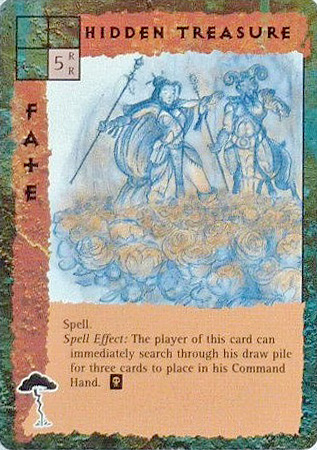
| Die | Result |
| 1-3 | Invisibility |
| 4-5 | Illusion (to change or hide appearance)
|
| 6 | Secret door under container |
| 7-8 | Secret compartment in container |
| 9 | Inside ordinary item in plain view |
| 10 | Disguised to appear as something else |
| 11 | Under a heap of trash/dung |
| 12-13 | Under a loose stone in the floor |
| 14-15 | Behind a loose stone in the wall |
| 16-20 | In a secret room nearby |
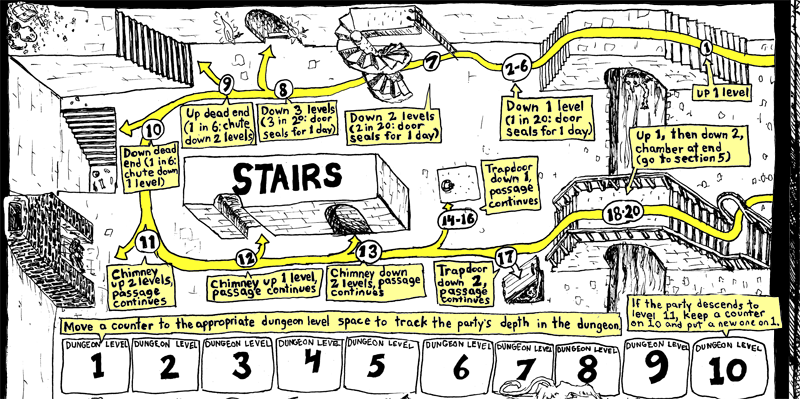
| Die | Result |
| 1-5 | Down 1 level* |
| 6 | Down 2 levels** |
| 7 | Down 3 levels*** |
| 8 | Up 1 level |
| 9 | Up dead end (1 in 6 chance to chute down 2 levels) |
| 10 | Down dead end (1 in 6 chance to chute down 1 level) |
| 11 | Chimney up 1 level, passage continues, check again in 30' |
| 12 | Chimney up 2 levels, passage continues, check again in 30' |
| 13 | Chimney down 2 levels, passage continues, check again in 30' |
| 14-16 | Trap door down 1 level, passage continues, check again in 30' |
| 17 | Trap door down 2 levels, passage continues, check again in 30' |
| 18-20 | Up 1 then down 2 (total down 1), chamber at end (roll on TABLE V.) |
* 1 in 20 has a door which closes egress
for the day.
** 2 in 20 has a door which closes egress
for the day.
*** 3 in 20 has a door which closes egress
for the day.
N.B. Check for such doors only after descending steps if playing solo!
TABLE VII.: TRICK/TRAP (d20) <(Optional: d6, 1-3 = TRICK, 4-6 = TRAP)>
| Die | Result |
| 1-5 | Secret Door
unless unlocated:
Non-elf locates 3 in 20, elf locates 5 in 20, magical device locates 18 in 20 (then see TABLE II.). Unlocated secret doors go to die 6,7 below. |
| 6-7 | Pit, 10' deep, 3 in 6 to fall in. |
| 8 | Pit, 10' deep with spikes, 3 in 6 to fall in. |
| 9 | 20' x 20' elevator room (party has entered
door directly ahead and is in room),
descends 1 level and will not ascend for 30 turns. |
| 10 | As 9. above, but room descends 2 levels. |
| 11 | As above, but room descends 2-5 levels
--
1 upon entering and 1 additional level each time an unsuccessful attempt at door opening is made, or until it descends as far as it can. This will not ascend for 60 turns.
|
| 12 | Wall 10' behind slides across passage blocking it for from 40-60 turns. |
| 13 | Oil (equal to one flask) pours on random person from hole in ceiling, followed by flaming cinder (2.12 h.p. damage unless successful save vs. magic is made, which indicates only 1-3 h.p. damage). |
| 14 | Pit, 10' deep, 3 in 6 to fall in, pit walls move together to crush victim(s) in 2-5 rounds. |
| 15 | Arrow trap, 1-3 arrows, 1 in 20 is poisoned. |
| 16 | Spear trap, 1-3 spears, 1 in 20 is poisoned. |
| 17 | Gas; party has detected it, but must breathe
it to continue along corridor, as it covers 60' ahead.
Mark map accordingly regardless of turning back or not. (See TABLE VII. A.) |
| 18 | Door falls outward causing 1-10 hit points,
or stone falls from ceiling causing 2-20 hit points of damage to each person failing his saving throw versus petrification. |
| 19 | Illusionary wall concealing
8. (pit) above (1-6), 20. (chute) below (7-10) or chamber with monster and treasure (11-20) (see TABLE V., 15-17). |
| 20 | Chute down 1 level (cannot be ascended in any manner). |
TABLE VII. A.: GAS SUB-TABLE (d20)
| Die | Result |
| 1-7 | Only effect is to obscure vision when passing through. |
| 8-9 | Blinds for 1-6 turns after passing through. |
| 10-12 | Fear: run back 120' feet unless saving throw versus magic is made. |
| 13 | Sleep: party sound asleep for 2-12 turns (as sleep spell). |
| 14-18 | Strength: adds 1-6 points of strength (as strength spell) to all fighters in party for 1 to 10 hours. |
| 19 | Sickness: return to surface immediately. |
| 20 | Poison: killed unless save vs. poison is made. |
-
CAVES
&& CAVERNS FOR LOWEST LEVELS:
You may wish to have
"roughhewn" and natural tunnels in lower
levels, and where rooms and
chambers are indicated substitute Caves
and Caverns. Exits are as above.
TABLE VIII.: CAVES AND CAVERNS
| Die | Result |
| 1-5 | Cave about 40' x 60' |
| 6-7 | Cave about 50' x 75' |
| 8-9 | Double Cave: 20' x 30', 60' x 60' |
| 10-11 | Double Cave: 35' x 50', 80' x 90'* |
| 12-14 | Cavern about 95' x 125'* |
| 15-16 | Cavern about 120' x 150' |
| 17-18 | Cavern about 150' x 200' * |
| 19-20 | Mammoth cavern about 250'-300' X 350'-4W** |
* Roll to see if pool therein (see TABLE VIII.A.).
** Roll to see if lake therein (see TABLE VIII.B.).
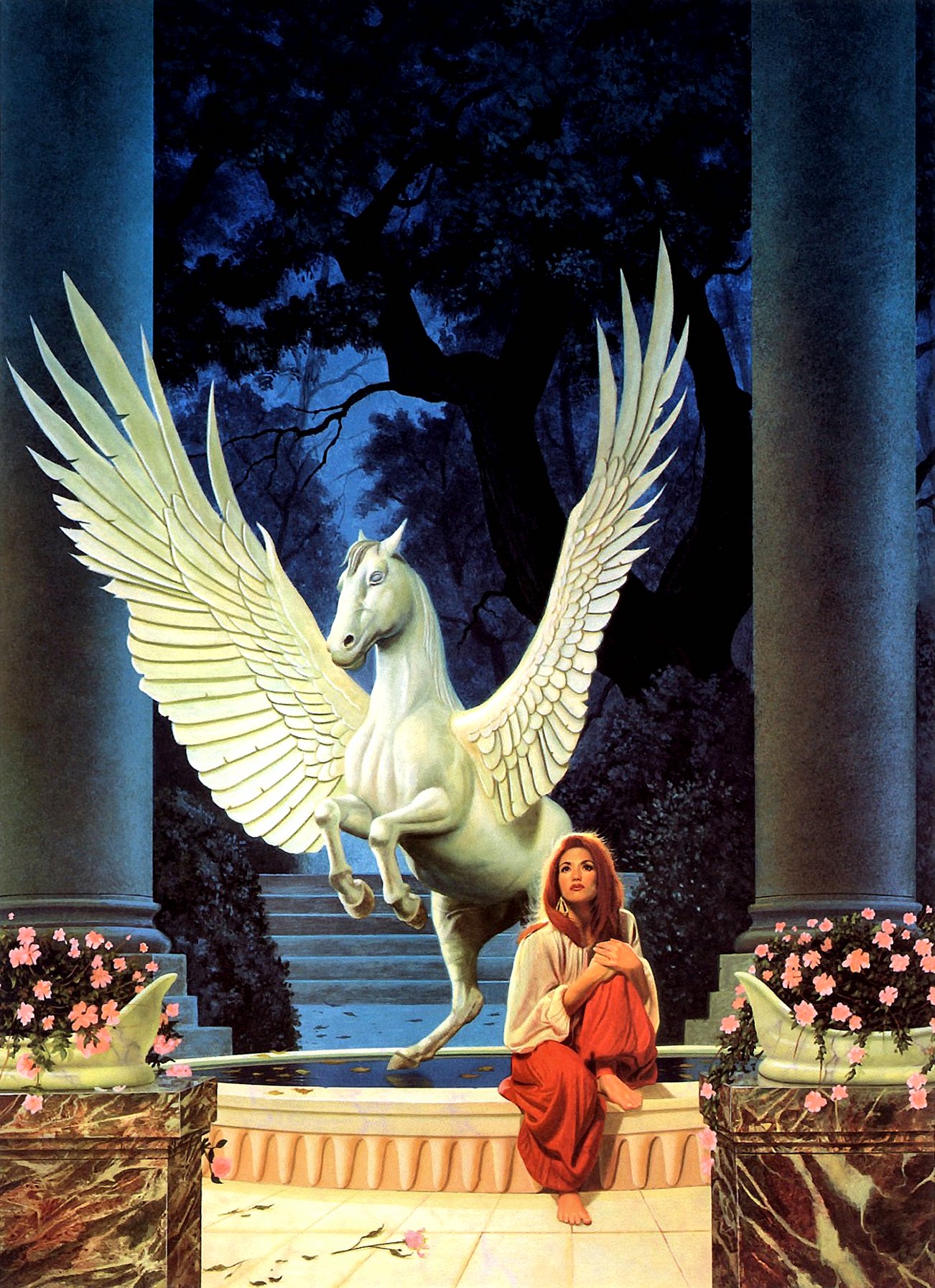
| Die | Result |
| 1-8 | No pool |
| 9-10 | Pool, no monster |
| 11-12 | Pool, monster |
| 13-18 | Pool, monster, and treasure |
| 19-20* | Magical pool |
TABLE VIII B.: LAKES (d20)
| Die | Result |
| 1-10 | No lake |
| 11-15 | Lake, no monsters |
| 16-18 | Lake, monsters* |
| 19-20 | Enchanted lake** |
* Determine monster and treasure from appropriate encounter matrix.
** Enchanted lake leads any who manage
to cross i t to another dimension,
special temple, etc. (if special map is
available, otherwise treat as lake
with monsters), 90% chance that monster
will guard lake.
TABLE VIII C.: MAGIC POOLS* (d20)
| Die | Result |
| 1-8 | Turns gold to platinum (1-11) or lead (12-20), one time only. |
| 9-15 | Will, on a one-time only basis, add (1-3)
or subtract (4-6) from one characteristic of all who stand within it:
1 = STR 2 = INT 3 = WIS 4 = DEX 5 = CON 6 = CHA (add or subtract from 1-3 points, checking for each character as to addition or subtraction, characteristic, and amount). |
| 16-17 | Talking pool which will grant 1 wish
to characters of its alignment
and damage others from 1-20 points. Wish can be withheld for up to 1 day. Pool's alignment is: lawful good 1-6, lawful evil 7-9, chaotic good 10-12, chaotic evil 13-17, neutral 18-20. |
| 18-20 | Transporter pool: 1-7, back to surface;
8-12, elsewhere on level;
13-16, 1 level down; 17-20, 100 miles away for outdoor adventure. |
* In order to find out what they are, characters must enter the magic pools.
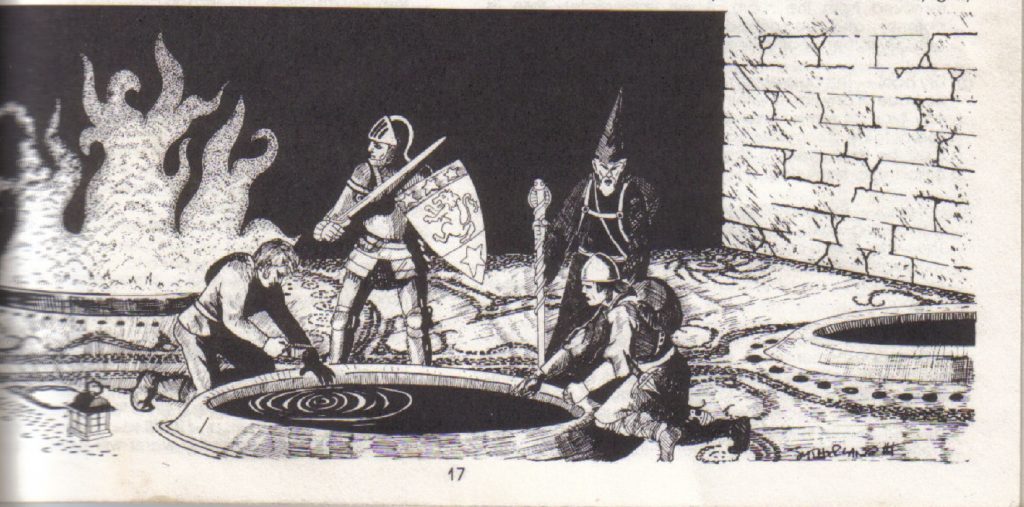
RANDOM DUNGEON GENERATION FOR SOLO PLAY
The random dungeon
generation system is easily adaptable to solitary play.
Locate the entrance to the dungeon, and
then select one of the random dungeon starting areas
given here, locating it in the middle of the graph paper.
Monsters: Inhabitants of the dungeon
are determined from the
DUNGEON ENCOUNTER
MATRIX.
For special areas you can have a friend
|| correspondent send you sealed information.
Listening at Doors:
Use a d12, and if a 1 is rolled, there is a
monster (with or without treasure).
Procedure is then normal, but surprise
is possible only on the monster's part.
ESP and
Other Detection Devices: Use a
6-sided die, a 1 indicating a
monster which will be known -- roll it
out, ignoring any undead or other
non-thinking monsters. Check other rooms,
chambers, etc. normally and
for any monster which can not be indicated
by the ESP or detection device
surprise is only possible on a roll of
1 on an 8-sided die.
Quote:
(2) Did you (or do you)
use the dungeon generation material (in the DMG) much? Or were most campaigns
and dungeons very carefully crafted?
Thank you again!!

I seldom used the random
dungeon generation system, although I found it useful on a few occasions.
That said, I wouldn't call
most of my dungeon levels "carefully crafted."
Especially themed ones were,
and I did my best to make all of them confusing to map, but that's more
workmanlike than otherwise.
The encounters were likewise
a mix or "whatever" and "this will knock their sox off" sorts, but some
features of many thrown together as mere mazes levels, had specially designed
and placed features.
Cheers,
Gary

Fid wrote:
Gary:
When making Castle
Greyhawk and other dungeon maps in "ye olden tymes", did you ever rely
on the Random Dungeon Generation tables in the 1e DMG (or something similar)
as a starting point?

No, not for Castle Greyhawk.
There I always had an idea in mind, frew out each level with ruler and
template.
I did use random dngeon generation for such places discovered in oytdoor adventuring by the PC party.
Cheers,
Gary

serleran wrote:
Did you ever use the random
dungeon creation system found in the OAD&D DMG?
That section has always
been something of great interest to me (so much, in fact, I wrote my own
soon to be published by our Trollish friends.)

Heh...
But of course.
What appears in the DMG is
the result of my devising and using the random dungeon generation system ![]()
I just didn't use it very
often with my player group, as I had lots of dungeon levels ready to go.
It came in handy when a
dungeon was discovered during a free-form outdoor
adventure.
Cheerio,
Gary

Quote:
Originally posted by MerricB
I've just been using your
Random Dungeon tables in the 1E DMG to create an "on-the-fly" dungeon for
my players, due to a couple of decisions they made that surprised me.
Lots of fun was had by all
- I must thank you heartily for those tables, and the additional suggestions
for tricks in the DMG appendices! A couple of 'elevator' rooms have confused
the mapper mightily, and the final encounter with an intelligent throne
with the powers of sex-change, gem-granting and teleportation have led
to a cliff-hanger where the mapper has been teleported off onto a solo
quest. The other characters haven't yet realised he has the only map... ![]()

Happy to hear that, and
I did indeed use the same for more than a few "scratch" adventures done
on the fly.
I feeely admit I love to
DM dungens where exploration is at least as important as the encounters,
solving the problems and defeating the tricks and traps a major feature
of the whole.
Rob had some very nasty stuff
like that in his dungeons, and I swan I am still at a loss as to one.
It seemed every time my
PC would pick up a loose gem--usually not more than 1-100 GP value, but
sometimes greater, so the lure was irrestible--he'd soon be teleported
to some other place, sometimes a most unpleasant one.
Never did figure out if
it was the gems proper or some other nearby thing that activated the transferrance ![]()
Quote:
Originally Posted by Wolv0rine
When the time finally comes
(may it be far, far off) I think someone with loads of cash should build
an E. Gary Gygax Museum designed with the Random Dungeon Generator from
the 1E DMG. ![]()

Now there's an idea ![]()
A subterranean fun house,
where the "treasures" gained from succeeding in getting past the encounters
would be viewing exhibits with my stuff on display, maybe a pic of the
"victor" doing so as proof of success.
Cheers,
Gary
Quote:
Originally Posted by mistere29
Gary, i read in an old interview
"by creating the village of Hommlet and the temple [sic] of Elemental Evil to test some ideas I had about random dungeons, and outdoor terrain so forth."
Could you eleaborate a bit
on this. Was the pre-Metzner draft largely designed by the random tables
in the dmg?

Howdy!
The village
and main temple areas were carefully mapped before I began adventure sessions
in the area.
The random generation was
used mainly in developing the land around the village and some of the side
areas surrounding the main rooms I had done for the temple
dungeons.
As a side note, the random
tables worked quite well, but they took too long.
I found that it was easier
and quicker for me to just bash ahead as usual and put in whatever I liked
at the moment.
Cheers,
Gary
